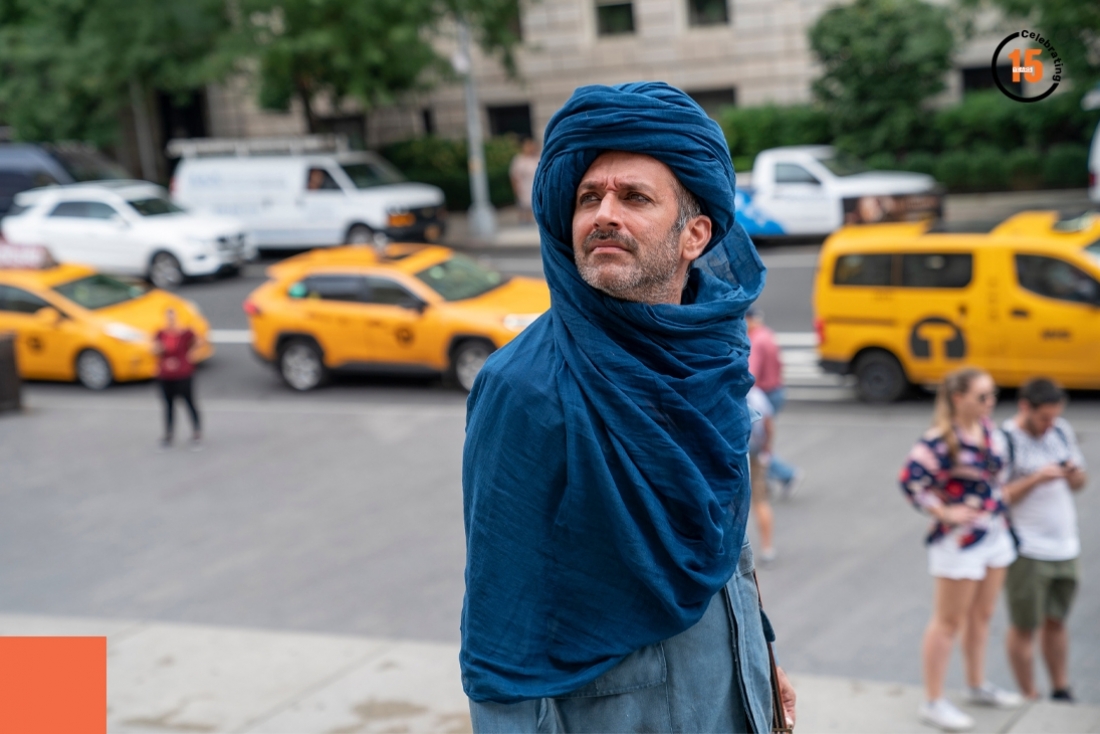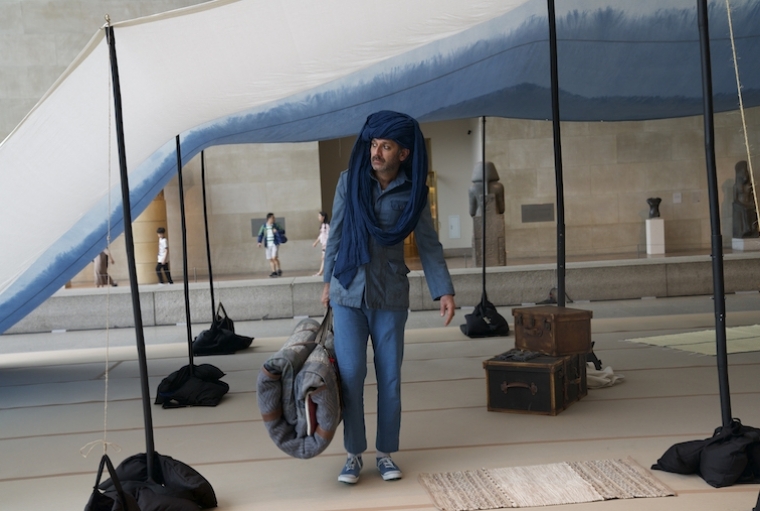
Nikhil Chopra, 2019–20 Artist in Residence, Lands, Waters, Skies at The Metropolitan Museum of Art.

Nikhil Chopra, 2019–20 Artist in Residence, Lands, Waters, Skies at The Metropolitan Museum of Art.
To attempt an introduction to Nikhil Chopra is futile—he is devoid of definitions and detached from everything he has ever been. Through his latest nine-day act at the Metropolitan Museum of Art, New York, he makes history—this is the first time in 150 years of The Met that a contemporary artist has made a long durational performance art work in the museum. Exploring the artist and the act.
Would you call yourself a nomad?
Erika Fischer-Lichte, professor at Freie Universität Berlin and author of Transformative Power of Performance, said to me when I spoke about my roots in Kashmir, “Trees have roots, humans have legs”. And that’s what we do with our legs, we move. I have been in Goa now for seven years and this is the longest I have stayed in one place continuously in my life. My father had a bank job and was transferred every three years. I grew up all over India and the Middle East. My adult life has been spent between Mumbai, Baltimore, Columbus, New York, Berlin and Goa. Yes I am a nomad. And now my art is making me a traveller. With my base in Goa, I am moving all the time. And each place and person I have visited and met has carved itself into my personality. I am at this very moment, the sum total of all my experiences. My scars and marks tell my story.
You assumed that role for Skies, Lands and Waters at The Met. Can you define the exhibit in your own words?
Skies, Lands and Waters is the title of the nine-day performance art installation commissioned by the Metropolitan Museum of Art, New York, fondly known as The Met. The Met on Fifth Avenue epitomizes the definition of a museum; its collection of objects spans 20,000 years of human culture across six continents. It is the second most visited museum in the world with a staggering 7 million visitors a year.
I am a performance artist and I am also a painter. While inside the Museum my time was spent making a large drawing measuring 58x20 feet on cotton fabric. I was stretching, or rather deconstructing a landscape painting and its make up, dissecting its very elements into sky, land and water, and smearing them across the three locations inside the museum over a period of eight days continuously.
I wanted to quite literally migrate from one end of the museum to the other, traverse time and space like a nomad collecting narratives, making the drawing as a way to notate distance, between one place and the other, and between one moment and the other. I began outside the museum. My first action was to move into the museum through the main Fifth Avenue entrance, piece-by-piece, box-by-box. I gathered my things first in the Great Hall, this is where everyone buys tickets and coat checks. From here I moved slowly to the platform in front of the Temple of Dendur, an Ancient Egyptian Temple, dismantled, shipped to the US and reconstructed at The Met in the 1960s. After two full days here of drawing the sky, I dismantled my set and move to the threshold-way between the galleries that house Arts from Oceania and Modern and Contemporary Art, moving one box at a time, taking a break in the Medieval Hall between to the two points. In the threshold-way, against the wall, I drew the image of rocks and land.
I ended up at the Lehman Courtyard with an Italian Renaissance fountain for the last act of the performance. It is by the exhibition titled In Praise of Painting, an exhibition of Dutch Masters, that my painting’s last element, namely water, got drawn on the canvas. The trickling fountain helped evoke this. In each location the configuration and orientation of the cotton canvas changed, as did the persona that I played. As the performance moved and migrated the various transformations were marked and articulated in the performance.
What inspired the act?
In this milieu of art and artifacts that stand the test of time, I am compelled to think about my body along with the thousands of bodies that come through the museum, as consumers of and then the containers of the objects we look at; at what they evoke in the present as well as what they stood for in the past.
I use performance as a means to unpack the self. I am looking for the common thread that runs through all of us; hunger, thirst, love, lust, greed, anger, joy, pain, passion, sorrow and fear. We are all physically connected to each other by land and water, living out our lives and our rainbow of emotions under one sky.
From New York, to Kashmir where my family comes from, to Goa where I live now, between one home and another, in my drawings, I continue to work with the mountains, the sea and the skies that connect them. In my art I am in search of the sublime. Like a hopeless romantic, the melancholia and irony in my performance reflect the mess of the world we as humans continue to make. I use drawings as a means of confronting the fragility of the wilderness and our place on the planet. Performance is a way to bring to attention the process of making a drawing as an act that is both personal and political. The labour and concentration required to make a thorough drawing is part of the spectacle.
The act of questioning is the act of answering. Your views.
Why would I give you an answer? Wouldn’t that close the conversation? Doesn’t the question precede the answer? Doesn’t the question generate the dialogue? Can I answer this question with a question? I’d much rather leave you with a series of questions. I don’t necessarily present the answer. The “work” is the “figuring-out”. As soon as I have an answer, at that very moment a new question is generated.
What research went into creating this work and the characters therein? Can you take me behind your creative process?
As a live artist, my work is often reacting to a site. Visiting a place, in this case repeatedly, has allowed for a deeper understanding of the context within which the performance will be carried out. During my visits to The Met I spent time at the museum in its various galleries, in spaces, among objects, in spaces as objects and amongst thousands of people. On a rainy day The Met often felt more like a public space with a utility like Grand Central train station. How the thousands of people negotiate through the museum, what are the favorite sites and object and what are the least visited galleries, was an observation that determined where in the museum I would perform.
I work with a small close-knit team of collaborators, who bring their sharp talent and expertise to the project. E.g. Costumes shape the personae I play. My work with Loise Braganza to design clothes for the performance is crucial work. We spend hours researching, concepting, designing, sourcing, tailoring, embroidering and fitting. I spend a lot of time in my studio in Goa making drawings and compositions to sharpen my skills. Spending time with my family in Goa, going on long monsoon walks through paddy field, cooking in my kitchen, working with the local communities as an artist, facilitator and pedagog, are all part of the creative process.

Photography: Shivani Gupta
Nikhil Chopra, 2019–20 Artist in Residence, Lands, Waters, Skies at The Metropolitan Museum of Art.
How has The Met been supportive and how did the collaboration shape up?
The museum has been very supportive. Every department has expressed their curiosity and enthusiasm for the project. So far it has been seamless. My link to The Met is through curator Shanay Jhaveri. I have known Shanay since 2010 when he visited a performance exhibition I was presenting titled Yog Raj Chitrakar: Memory Drawing X at the Bhaudaji Lad Museum in Mumbai with Chatterjee & Lal. Shanay was in his early 20s when he wrote an essay in reaction to his observation of the piece. This text moved me deeply. Shanay’s read and understanding of the work was mature and articulate, he got it! The text became the lead essay for a publication we put out that very year. Since then there has been a mutual interest in each other’s development. As he takes on the role of curator for Modern and Contemporary at the Metropolitan Museum of Art, it becomes both natural and urgent for him to invite me to make a new performance work for the museum, to challenge the workings of a major public institution while being inspired by one of the most diverse collections of art in the world.
This project brings together the departments of Modern and Contemporary and Live Art. Limor Tomer of Live Arts is a stellar curator and producer. So the collaborations have happened on many levels. This too is another first: to have different departments in an enormous institute come together to make a contemporary-performance-drawing-installation possible.
How challenging is it to keep up an act for nine days?
It is as challenging as a nine-days mountain trek. It has its highs and lows. Time is an important element in my practice. I use time like material. In order to immerse myself in my performance I must separate myself from my daily familiar self. If I am to feel the trans- formative power of my work I need to spend time with it. The cycle of day and night, from sleep to awake, from hunger, thirst and fatigue to rejuvenation, I go through many emo- tions, thoughts and changes. At The Met I wanted to be the refrigerated object encased in the museum for eight days. This transformed me and hopefully a few people around me, too. Your views on performance art in the age of YouTube.
YouTube is a product. Google is its owner. We are their active clients. Performance art has very little to do with any of the above. It is in the body of an individual where the core of all thought and experience lie. I don’t want to lose touch with the live-ness of life, the unmediated experience, the sensation of touch, smell and taste. Love is in the body and not in a machine. Perhaps performance art in its live-ness can remind us of this.
When do you catch yourself not in performance?
My performance started when I was born and will end when I die. Life is a performance and living it is performing it. To perform is simply to do. The biggest challenge in front of you. My biggest challenge is to live a healthy and fulfilling life. I have two children aged eleven and six, while I am not a worrying parent, the challenge that I share with most parents is; how to bring up responsible, caring, loving, sensitive, fearless, self aware, strong willed, opinionated, positive thinking citizens of the world at a time when our presence on this planet is the biggest problem?
This article was initially published in our October 2019 Bookazine and we are revisiting it as a part of our Celebrating 15 Years Platform magazine series.
Text Soumya Mukerji